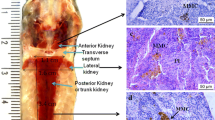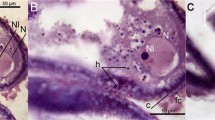Abstract
Follicular atresia is a common feature of the vertebrate ovary that occurs at different stages of folliculogenesis and ovarian regression. It has physiological significance to maintain homeostasis and control fecundity, and ensure removal of post-ovulatory follicular remnants for preparing the ovary for the next cycle. Pigments appear late in the atretic process as indigestible waste formed out of the degradation of the oocytes, follicle wall and granulocytes. In the present study, pigment accumulation was demonstrated by Schmorl’s and Perls’ staining methods in the atretic ovarian follicles of Heteropneustes fossilis during follicular development and regression. Melanins were characterized spectrophotometrically for the first time in fish ovary. The predominant form is eumelanin, followed by pheomelanin and alkali-soluble melanin. Melanins showed significant seasonal variations with levels low in gonad resting phase, increasing to the peak in the post-spawning phase. The concentration of melanins increased time-dependently in post-ovulated ovary after human chorionic gonadotropin treatment. In the spawning phase, in vitro incubation of ovary slices with estradiol-17β or dexamethasone for 8 or 16 h decreased both eumelanin and pheomelanin levels time-dependently. The alkali-soluble melanin showed a significant decrease only in the dexamethasone group at 16 h. The results show that melanin assay can be used as a biomarker of follicular atresia in fish ovary, natural or induced by environmental toxicants.








Similar content being viewed by others
References
Agius C (1985) The melano-macrophage centres of fish: a review. In: Manning MJ, Tatner MF (eds) Fish immunology. Academic Press, London, pp 85–105
Agius C, Roberts RJ (2003) Melano-macrophages centres and their role in fish pathology. J Fish Dis 26:499–509
Bancroft JD, Gamble M (2008) Theory and practice of histological techniques, 6th edn. Churchill Livingstone, London
Besseau L, Faliex E (1994) Resorption of unemitted gametes in Lithognathus mormyrus (Sparidae: Teleostei): a possible synergic action of somatic and immune cells. Cell Tissue Res 276:123–132
Billig H, Furuta I, Hsueh AJW (1993) Estrogens inhibit and androgens enhance ovarian granulosa cell apoptosis. Endocrinology 133:2204–2212
Blazer VS (2002) Histopathological assessment of gonadal tissue in wild fishes. Fish Physiol Biochem 26:85–101
Bretschneider LH, Duyvene-De Wit J (1947) Sexual endocrinology of non-mammalian vertebrates, vol 11. Elsevier, Amsterdam
Fan R, Yang G, Dong C (2010) Study of hair melanins in various hair color Alpaca (Lama pacos). Asian Aust J Anim Sci 23:444–449
Fostier A, Jalabert B, Billard R, Breton B, Zohar Y (1983) The gonadal steroids. In: Hoar WS, Randall DL, Donaldson EM (eds) Fish physiology, vol 9A (reproduction). Academic Press, New York, pp 277–372
Guraya SS (1976) Recent advances in the morphology, histochemistry, and biochemistry of steroid-synthesizing cellular sites in the non-mammalian vertebrate ovary. Int Rev Cytol 44:365–409
Guraya SS (1986) The cell and molecular biology of fish oogenesis. In: Sauer HW (ser. ed) Monographs in developmental biology, vol 18. S Karger AG, Basel, pp 1–223
Guthrie HD, Grimes RW, Cooper BS, Hammond JM (1995) Follicular atresia in pigs: measurement and physiology. J Anim Sci 73:2834–2844
Hasumi M (1996) Seasonal fluctuations of female reproductive organs in the salamander Hynobius nigrescens. Herpetologica 53:598–605
Haugarvoll E, Thorsen J, Laane M, Huang Q, Koppang EO (2006) Melanogenesis and evidence for melanosome transport to the plasma membrane in a CD83+ teleost leukocyte cell line. Pigment Cell Res 19:214–225
Hughes FM Jr, Gorospe WC (1991) Biochemical identification of apoptosis (programmed cell death) in granulosa cells: evidence for a potential mechanism underlying follicular atresia. Endocrinology 129:2415–2422
Ito S (2003) A chemist’s view of melanogenesis. Pigment Cell Res 16:230–236
Ito S, Fujita K (1985) Microanalysis of eumelanin and pheomelanin in hair and melanomas by chemical degradation and liquid chromatography. Anal Biochem 144:527–536
Ito S, Wakamatsu K, Ozeki H (1993) Spectrophotometric assay of eumelanin in tissue samples. Anal Biochem 215:273–277
Ito S, Wakamatsu K, Ozeki H (2000) Chemical analysis of melanins and its application to the study of the regulation of melanogenesis. Pigment Cell Res 13:103–109
Janz DM, Kraak GVD (1997) Suppression of apoptosis by gonadotropin, 17β-estradiol, and epidermal growth factor in rainbow trout preovulatory ovarian follicles. Gen Comp Endocrinol 105:186–193
Kasuya K (1997) Elimination of apoptotic granulosa cells by intact granulosa cells and macrophages in atretic mature follicles of the guinea pig ovary. Arch Histol Cytol 60:175–184
Kennedy AM (2002) Reproduction of striped bass Morone saxatilis; a structural, biochemical and functional characterization of atresia. http://www.lib.ncsu.edu/theses/available/etd-06162002-210408/
Lambert JGD (1970) The ovary of the guppy, Poecilia reticulata. The atretic follicle, a corpus atreticum or a corpus luteum praeovulationis. Z Zellforsch 107:54–67
Meseguer J, Lopez-Ruiz A, Esteban MA (1994) Melano-macrophages of the seawater teleosts, sea bass (Dicentrarchus labrax) and gilthead seabream (Sparus aurata): morphology, formation and possible function. Cell Tissue Res 277:1–10
Miranda ACL, Bazzoli N, Rizzo E, Sato T (1999) Ovarian follicular atresia in two teleost species: a histological and ultrastructural study. Tissue Cell 31:480–488
Morais RDVS, Thome RG, Lemos FS, Bazzoli N, Rizzo E (2012) Autophagy and apoptosis interplay during follicular atresia in fish ovary: a morphological and immunocytochemical study. Cell Tissue Res 347:467–478
Nagahama Y (1983) The functional morphology of teleost gonads. In: Hoar WS, Randall DL, Donaldson EM (ed) Fish physiology, vol 9A (reproduction). Academic Press, New York, pp 223–275
Nezirevic D, Arstrand K, Kagedal B (2007) Hydrophilic interaction liquid chromatographic analysis of aminohydroxyphenylalanines from melanin pigments. J Chromatogr A 1163:70–79
Ozeki H, Ito S, Wakamatsu K, Hirobe T (1995) Chemical characterization of hair melanins in various coat—color mutants of mice. J Invest Dermatol 105:361–366
Ravaglia MA, Maggese MC (1995) Melano-macrophage centres in the gonads of the swamp eel, Synbranchus marmoratus Bloch, (Pisces, Synbranchidae): histological and histochemical characterization. J Fish Dis 18:117–125
Ribeiro HJ, Procopio MS, Gomes JMM, Vieira FO, Russo RC, Balzuweit K, Chiarini-Garcia H, Casrro ACS, Rizzo E, Correa JD (2011) Functional dissimilarity of melanomacrophage centres in the liver and spleen from females of the teleost fish Prochilodus argenteus. Cell Tissue Res 346:417–425
Saidapur SK (1978) Follicular atresia in the ovaries of nonmammalian vertebrates. Int Rev Cytol 54:225–244
Santos HB, Thome RG, Arantes FP, Sato Y, Bazzoli N, Rizzo E (2008) Ovarian follicular atresia is mediated by heterophagy, autophagy, and apoptosis in Prochilodus argenteus and Leporinus taeniatus (Teleostei: Characiformes). Theriogenology 70:1449–1460
Sathyanesan AG (1961) The ovarian cycle in the catfish Mystus seenghala (Sykes). Proc Natl Inst Sci India 28:497–506
Singh V, Chaube R, Chourasia TK, Joy KP (2010) Temporal and periovulatory changes in ovarian catecholamines in the catfish Heteropneustes fossilis. Gen Comp Endocrinol 168:46–54
Tilly JL, Kowalski KI, Johnson AL, Hsueh AJW (1991) Involvement of apoptosis in ovarian follicular atresia and postovulatory regression. Endocrinology 129:2799–2801
Ucuncu SI, Cakıcı O (2009) Atresia and apoptosis in preovulatory follicles in the ovary of Danio rerio (zebrafish). Turk J Fish Aquat Sci 9:215–221
Van den Hurk R, Peute J (1985) Functional aspects of the postovulatory follicle in the ovary of the African catfish, Clarias gariepinus, after induced ovulation. Cell Tissue Res 240:199–208
Wakamatsu K, Ito S (2002) Advanced chemical methods in melanin determination. Pigment Cell Res 15:174–183
Watanuki H, Yamaguchi T, Sakai M (2002) Suppression in function of phagocytic cells in common carp Cyprinus carpio L. injected with estradiol, progesterone or 11-ketotestosterone. Comp Biochem Physiol C: Toxicol Pharmacol 132:407–413
Wood AW, Van Der Kraak GJ (2001) Apoptosis and ovarian function: novel perspectives from the teleosts. Biol Reprod 64:264–271
Ziengenfuss MC, Wolke RE (1991) The use of fluorescent microspheres in the study of piscine macrophage aggregate kinetics. Dev Comp Immunol 15:165–171
Acknowledgments
RK is a recipient of Rajiv Gandhi National Fellowship of UGC, New Delhi, which is gratefully acknowledged.
Author information
Authors and Affiliations
Corresponding author
Rights and permissions
About this article
Cite this article
Kumar, R., Joy, K.P. Melanins as biomarkers of ovarian follicular atresia in the catfish Heteropneustes fossilis: biochemical and histochemical characterization, seasonal variation and hormone effects. Fish Physiol Biochem 41, 761–772 (2015). https://doi.org/10.1007/s10695-015-0044-y
Received:
Accepted:
Published:
Issue Date:
DOI: https://doi.org/10.1007/s10695-015-0044-y




